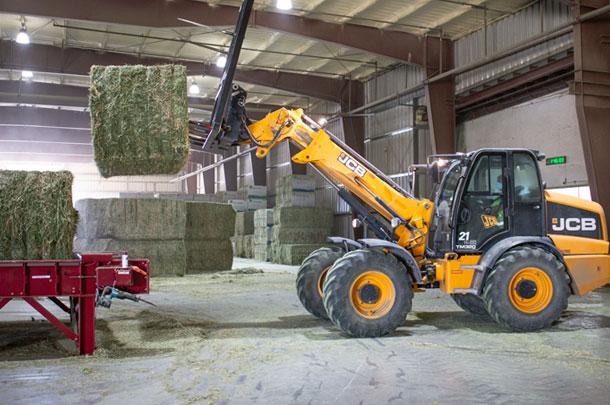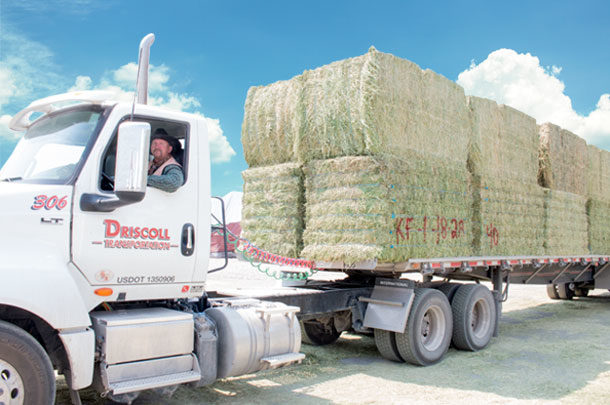Driscoll increased their alfalfa production to around 5,000 acres of new alfalfa in Idaho and also contracted alfalfa from eastern Idaho growers to take the plant to near capacity. They currently run two 10-hour shifts, five days per week and compress 300 to 450 metric tons per day.
Bret Mortensen, general manager at the press facility, says nearly 100 percent of the hay pressed through the facility is conventional hay because the largest share of their market is in China and Vietnam. Mortensen says, “We load the containers here with compressed hay and they’re trucked to Salt Lake City, and from there the hay is loaded onto rail cars and transported to California ports for shipping.”
“We make great hay here in Idaho, but since the facility is inland and we have to use the rails, sometimes it’s slow getting product to the ports,” Mortensen says. Some exporters advised they might have trouble getting shipping containers, but Mortensen says that hasn’t been the case. He says a typical load of hay takes 30 to 45 days to get from Idaho to China.
Raw bales go into the press at 12 percent moisture, generally in the 140 to 200 relative feed value range. Hay is tested in the stack by a field man, tested again by the drivers when they pick up the load, tested a third time when it’s unloaded at the facility and tested again before it goes into the press.
Mortensen says some dairymen in the area expressed concern the export facility would drive up hay prices in an already tight profit margin era within the dairy industry. However, the added acres from Driscoll Brothers – along with other farmers taking out less profitable row crops and converting them to alfalfa – has resulted in minimal, if any, hay price increases. Will Ricks, president of the Idaho Hay Association, says, “I don’t think Driscolls have that much effect. I think they are right that more acres have been planted.”
Eric Larsen, a nearby hay producer in Blackfoot, Idaho, says, “I do think Driscoll is having an impact on our market. I see a lot of their trucks drive around loaded with hay. I think they have helped clean up a lot of hay inventory. Whether they are directly or indirectly the cause of hay being moved, I think they have made people buy hay that would typically hold off on buying or even might not normally buy. I think it’s great to get more competition in the hay markets.”

The most recent USDA forecast for alfalfa hay production in the U.S. shows Idaho with a 10 percent increase in alfalfa acres (110,000-acre increase). This helps offset the reduction of alfalfa acres forecasted for Washington (-3 percent) and Oregon (-16 percent). Alfalfa hay production for 11 Western states indicates an overall increase of 2 percent, and the acreage increase for the entire U.S. is forecasted at 5 percent.
I asked John Szczepanski, director of the U.S. Forage Export Council (USFEC), about the current export climate:
Q. What are areas of strength for export hay markets right now?
SZCZEPANSKI: A big strength of the export forage industry has been in the systems developed to secure, process and ship product, and to be able to do it safely and efficiently and satisfy the regulatory and commercial requirements of any export destination. This is a market with thin margins and a lot of expectations, and it says a lot about the systems that can make it happen. For the Chinese market, for example, there are requirements for field inspections and tests, and product bound for China has to be segregated. Meanwhile, the Japanese market will buy a full range of forages, and customers make distinctions about small differences in color and the size of leaves and stems. Understanding your customer’s needs is only part of the challenge. An exporter needs to have systems in place to meet those needs.
Q. What are areas of weakness for export hay markets?
SZCZEPANSKI: As much as systems are a strength of the export forage industry, they’re only worthwhile if the processes are followed. For example, the Chinese government has a zero tolerance for genetically modified alfalfa. Some exporters are testing three times to ensure that the product they ship is GMO-free. If an exporter isn’t testing, they risk not just their own business, but they threaten the well-being of the whole export market. If a grower knowingly sells to an exporter who doesn’t test, that presents a risk to their farm as well. They might be assured by the buyer that everything’s OK, but then they’d be taking the word of a company that’s breaking government regulations, so how good is their word?
Q. What are opportunities for international hay markets moving forward?
SZCZEPANSKI: There are still many opportunities for export forage. Some trends are solidly established: a growing global middle class and shifting consumption patterns, greater dairy consumption and the development – to satisfy those demands – of modern dairies. Many new dairies are being built in Southeast Asia. What we’ve seen in many countries is initial investment in machinery, top-notch genetics and even the hiring of world-class personnel. Often the last piece of the puzzle is quality feed: After all that investment, management recognizes that without quality feed, they cannot achieve world-class yields. And that’s an opportunity for U.S. forage. Despite growing competition from around the world, the U.S. still offers the highest quality of forage.
Q. To date, what impact has trade negotiations had on hay exports directly?
SZCZEPANSKI: It’s still early to estimate how much impact the tariffs will have on forage exports, but obviously the impact will be negative. With already tight margins, the Chinese market can’t bear the added costs of the newly imposed tariffs. Customers aren’t pursuing new contracts and are delaying the product they’ve already ordered. It’s frustrating to have no control, but we appreciate we’re not the only industry affected. U.S. forage exporters are working with their Chinese customers to maintain the good relations that have built this nearly half-billion dollar market.
Q. What other “threats” could potentially cause issues for hay exports?
SZCZEPANSKI: As global demand increases for high-quality forage, there are a lot of suppliers trying to improve their systems to get into the market. Exporters and growers have to be vigilant and dedicated to maintain the U.S. advantage. With those thin margins, we need ports that are efficient, government officials who fight for us to open markets and to keep markets open. The U.S. Forage Export Council understands this, and our membership is committed to supporting and protecting this industry. ![]()
About USFEC/NHA: The U.S. Forage Export Council has 33 members who represent about a billion dollars in U.S. exports, or over 80 percent of all the forage shipped from the U.S. USFEC is a committee of the National Hay Association, which was established in 1895 and is dedicated to integrity in the hay industry.

-
Lynn Jaynes
- Managing Editor
- Progressive Forage
- Email Lynn Jaynes
PHOTO 1: A hay hauler delivers alfalfa hay to the new hay compressing facility in Pocatello, Idaho – Driscoll | Top Hay.
PHOTO 2: Most of the hay from the Driscoll | Top Hay facility is readied for the Chinese and Asian markets. Photos by Lynn Jaynes.












